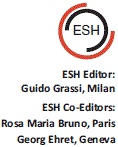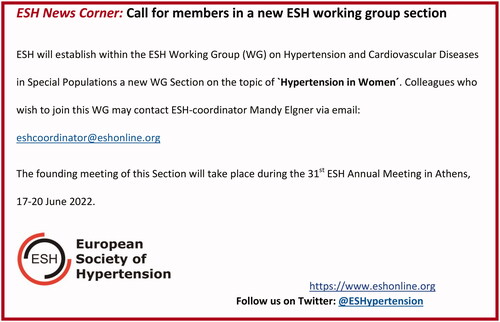Keywords:
Context
The optimal blood pressure (BP) targets during pregnancy in women with pre-existing (i.e. chronic) or new (after the 20th week, i.e. gestational) hypertension remain by and large empirically determined. Indeed, the evidence of different international guideline recommendations for antihypertensive treatment in pregnancy is mainly based on expert opinions. While in pregnant women with severe hypertension, the benefits of pharmacological BP-lowering treatment were clear, no evidence in pregnant women with mild hypertension was available until recently [Citation1].
Seven years ago, the Control of Hypertension in Pregnancy Study (CHIPS) [Citation2] evaluated whether less or more tight control of hypertension (i.e. achieved diastolic BP values less than 100 or 85 mmHg, respectively) was associated with different perinatal and maternal outcomes. In CHIPS, 987 pregnant women with non-severe and non-proteinuric chronic (75%) or gestational (25%) hypertension were enrolled at 14–33 weeks of gestation [Citation2]. The primary outcome was a composite of pregnancy loss or substantial long-standing intensive neonatal care, with serious maternal complications as a secondary outcome. Both outcomes were not different for an average diastolic BP reduction of 4.6 mmHg between the tight and less-tight BP control groups during follow-up. However, as expected from previous studies [Citation3], the development of severe hypertension, a non-prespecified secondary outcome, was 1.8-fold more frequent in the less tight compared to the tight diastolic BP control group [Citation2]. Finally, in the subgroup of women with chronic hypertension, less tight BP control was associated with lower rates of small-for-gestational-age newborns (p = 0.04) than tight BP control [Citation4]. Clearly, CHIPS is an important study, but some limitations should be noted: (1) the sample size was limited and several important analyses including the rates of small-for-gestational-age newborns were underpowered; (2) women with chronic or gestational hypertension were analysed in one group, which represents a potential bias for the clinical interpretation of the data; (3) women presenting with new chronic hypertension earlier in pregnancy than the 14–33 weeks enrolment window were not included; (4) although labetalol was considered the drug of choice, it was only used by two-thirds of women; (5) systolic BP control was not considered for the association with outcomes although it was monitored to detect more severe hypertension and (6) women with prior severe hypertension were more frequently randomised to less-tight control.
New evidence from CHAP
In April 2022, an important open-label multicentre randomised trial, the Chronic Hypertension and Pregnancy (CHAP), was published [Citation5]. The CHAP trial addressed the outcomes and safety of antihypertensive drug treatment in singleton-pregnancy women with mild chronic hypertension (). Antihypertensive drug treatment with a target below 140/90 mmHg (active-treatment group) was compared to a conservative strategy of withholding or stopping such treatment unless severe hypertension developed (control group). The CHAP trial outcomes were (1) preeclampsia with severe features or preterm delivery or placental abruption or foetal/neonatal death (primary outcome); (2) small-for-gestational-age newborn (safety outcome); and (3) serious neonatal or maternal complications or preeclampsia or preterm birth (secondary outcomes).
Table 1. Contemporary randomised studies of women with hypertension in pregnancy.
Of the 2408 participants, a majority of the population was Non-Hispanic Black (48%), while Non-Hispanic White and Hispanic women represented 28.7 and 19.7%, and 45 and 77% used aspirin at baseline or pre-delivery. The participants were enrolled before the 23rd week of gestation, and those at higher risk for severe hypertension development (i.e. treated with more than one antihypertensive agent at baseline) were excluded. The preferred drugs were labetalol or extended-release nifedipine (97% of participants). A combination drug treatment was only used after monotherapy dose escalation. The control group received similar antihypertensive medications only if severe hypertension developed (defined as systolic/diastolic BP 160/105 mmHg or more), otherwise remained untreated. During the in-pregnancy follow-up period, the achieved systolic/diastolic BP difference was 3.1/2.3 mmHg lower in the active treatment than in the control group. The composite primary outcome occurred 18% less frequently in the active-treatment group than in controls (95% confidence interval [CI], 8–27%), translating to a number of women ‘needed to treat’ to prevent one primary outcome event of 14. In subgroup analyses, placental abruption and foetal/neonatal deaths were not different between groups, but both of the following primary outcome components were reduced in the active treatment compared to the control group: (1) preeclampsia with severe features by 20% (95% CI, 8–30%) and (2) preterm birth for medical reasons by 27% (95% CI, 11–40%). The pre-specified composite maternal or neonatal secondary outcomes were not different between groups, including small-for-gestational-age newborns. Severe hypertension developed 18% less frequently in the active treatment compared to the control group (95% CI, 0.74–0.90), however, no stroke event occurred in either study group during the trial.
The CHAP trial adds thus important new randomised evidence to the body of knowledge of antihypertensive treatment during pregnancy, and the authors are to be commended for the successful conduction of this very important trial. However, despite our enthusiasm, we wish to note a number of limitations of the CHAP trial and still unanswered questions.
First, BP differences were most evident during the first half of the pregnancy, while in the second half, close to most outcomes adjudication, BP differences were less pronounced. A possible explanation might be that the active drug treatment strategy was of a limited intensity, and drug combinations were used only as a third-line step after the implementation of full-dose monotherapy. Second, given the design of the study and the high ratio of women excluded during pre-randomisation screening, the results cannot be generalised to all women with mild chronic hypertension, especially to those diagnosed (1) after the 23rd week of gestation, (2) during the second trimester but with BP levels below the threshold (because of the masking effect of physiological BP drop) and (3) in the context of multiple baseline antihypertensive treatment prone to severe hypertension later in pregnancy. Third, the lower safety margin, i.e. the BP level that is too low and potentially hazardous, still remains unclear. Fourth, while a strength of CHAP is the inclusion of a substantial number of women from three different ethnic groups (Non-Hispanic Black, Non-Hispanic White and Hispanic), the proportion of Asian women included was very low. Finally, the cross-over rate between groups would be interesting to add in a future communication.
Recent reviews, including a Cochrane analysis [Citation3], concluded insufficient data to determine the benefits and risks of antihypertensive therapy for mild-to-moderate hypertension in pregnancy (defined as systolic BP of 140–169 mmHg and diastolic BP of 90–109 mmHg). In addition, different guidelines for the treatment of hypertension in pregnancy vary concerning thresholds for starting treatment and BP goals ().
Table 2. Management of hypertension in pregnancy.
According to the current European Society of Cardiology/European Society of Hypertension guidelines for the management of Hypertension [Citation6], the systolic/diastolic BP thresholds at which to start antihypertensive treatment are 140/90 mmHg in women with:
Gestational hypertension with or without proteinuria;
Pre-existing hypertension and superimposed gestational hypertension;
Pre-existing hypertension with hypertension-mediated organ damage.
In other circumstances [Citation6], the above thresholds become more conservative (i.e. 150/95 mmHg). The critical appraisal of most recent trials may change BP thresholds in future guidelines.
Conclusion
CHAP is a very important study that provides further evidence for the management of mild chronic hypertension during pregnancy, a setting that is inherently difficult to study. The results of the study suggest that antihypertensive drug treatment for women with mild chronic hypertension with a BP target of less than 140/90 mmHg is advantageous and safe, but some limitations of the trial and unanswered questions remain. Physicians may consider the following: (1) identify and treat those at risk of severe hypertension; (2) advise the use of low-dose aspirin, ideally before the second half of the second trimester [Citation7]; (3) regularly monitor BP levels by using the recommended methodology for women in pregnancy [Citation6], especially in the second trimester to avoid overtreatment, placental hypoperfusion and loss of pregnancy, although we note that no randomised evidence is available to support this practice.
The ESH has just started a new Working Group Section (see ESH News Corner) to highlight issues related to the management of hypertension in women, including but not limited to pregnancy. The current ESH Clinical Update briefly reports the results of an important trial in hypertension in pregnancy, drawing attention to the fact that additional randomised trials in the field are desirable in different study populations.
Disclosure statement
No potential conflict of interest was reported by the authors.
References
- Greene MF, Williams WW. Treating hypertension in pregnancy. N Engl J Med. 2022;386(19):121–1847.
- Magee LA, von Dadelszen P, Rey E, et al. Less-tight versus tight control of hypertension in pregnancy. N Engl J Med. 2015;372(5):407–417.
- Abalos E, Duley L, Steyn DW, et al. Antihypertensive drug therapy for mild to moderate hypertension during pregnancy. Cochrane Database Syst Rev. 2018;10(10):CD002252.
- Magee LA, Singer J, von Dadelszen P. Less-tight versus tight control of hypertension in pregnancy. N Engl J Med. 2015;372(24):2367–2368.
- Tita AT, Szychowski JM, Boggess K, et al. Chronic hypertension and pregnancy (CHAP) trial consortium. Treatment for mild chronic hypertension during pregnancy. N Engl J Med. 2022;386(19):1781–1792.
- Williams B, Mancia G, Spiering W, et al. 2018 ESC/ESH Guidelines for the management of arterial hypertension: the task force for the management of arterial hypertension of the European society of cardiology and the European society of hypertension: the task force for the management of arterial hypertension of the European society of cardiology and the European society of hypertension. J Hypertens. 2018;36(10):1953–2041.
- Rolnik DL, Wright D, Poon LC, et al. Aspirin versus placebo in pregnancies at high risk for preterm preeclampsia. N Engl J Med. 2017;377(7):613–622.


